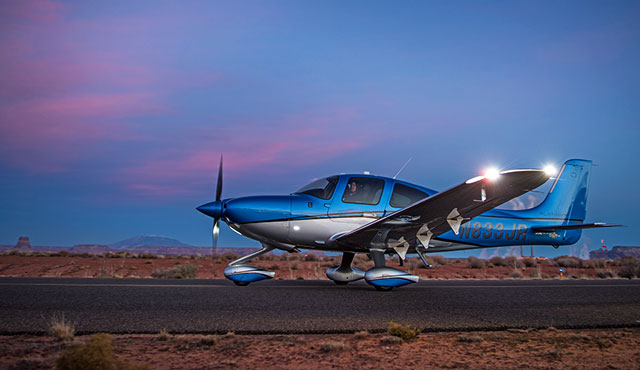
Night flight is an entirely new way to experience the joy of flying. But like anything, night flying comes with its share of challenges and risks.
Of all the senses, vision is the most important for safe flying. When flying in conditions with limited visibility as in nighttime operations, pilots can fall victim to optical illusions that compromise their safety. Understanding how to identify the different types of nighttime illusions can help pilots avoid potential accidents when flying at night.
Let’s take a closer look at five types of illusions that you might encounter in night flight:
Autokinesis
This illusion happens when a pilot stares at a bright, stationary light set against a pitch-black background, such as a star or the light from another aircraft. After a few seconds, the light could appear to be moving toward the aircraft. In an attempt to avoid the impending “collision,” the pilot may become disoriented and lose control of the aircraft. To prevent this illusion, avoid staring at one point of light for more than a few seconds and maintain a normal scan pattern.
The Black Hole Effect
On dark nights, approaching an airport that has few lights or identifiable ground features can create an illusion that the aircraft is at a higher attitude than it actually is. The black hole illusion, also called the featureless terrain illusion, can result in the pilot flying a too-low approach and crashing short of the runway.
The black hole illusion can also occur when taking off from a brightly-lit airport into a pitch-black, featureless sky. With no visual cues to reference, pilots can experience vertigo and disorientation. To combat these illusions, always trust the flight instruments to maintain orientation and a stable approach.
Flicker Vertigo
While rare, exposure to flickering lights can trigger an imbalance in brain-cell activity in some people, leading to disorientation, dizziness, nausea, confusion, headaches, and sometimes seizures and loss of consciousness. Flicker vertigo can be caused by a faulty light in the cockpit, beacon or navigation lights flickering through a rotating propeller, or other low-frequency flashing lights. It can be prevented by looking away from the light source when possible. Adjusting the RPM on approach or when taxiing can help to eliminate vertigo sensations caused by light flickering through a rotating propeller.
False Horizons
During the day, pilots can simply align with the natural horizon of the earth to maintain straight-and-level flight. But on dark nights when there’s no visible horizon, the brain can still trick itself into searching for a horizon to reference. For example, a sloping cloud formation, bright stars, or ground lights from a highway can create the illusion that the aircraft is not aligned with the horizon. Using these references, the pilot may align with an incorrect horizon and enter a dangerous attitude. To prevent this illusion, pilots flying at night should rely on the aircraft’s attitude indicator instead of depending on visual references.
Sloping Terrain Illusions
At night, an upward sloping runway or upward sloping terrain can create the illusion that the aircraft is higher than it actually is. To compensate, the pilot will fly a lower than normal approach, which could lead to a controlled flight into terrain accident. A down-sloping runway or down-sloping terrain can have the opposite effect, resulting in the pilot flying a higher than normal approach. When planning your route, consult airport diagrams for information on the runway’s slope, terrain, and lighting. As you approach the runway, refer to your altimeter to judge the aircraft’s height above the ground.
When it comes to night flying, seeing is not always believing. If you do encounter a visual illusion while flying at night, the solution is almost always to trust your instruments, not your eyes. Because pilots of all skill levels can be fooled by these illusions, it’s crucial to be knowledgeable and have confidence in your instruments to avoid the dangers of spatial disorientation at night.